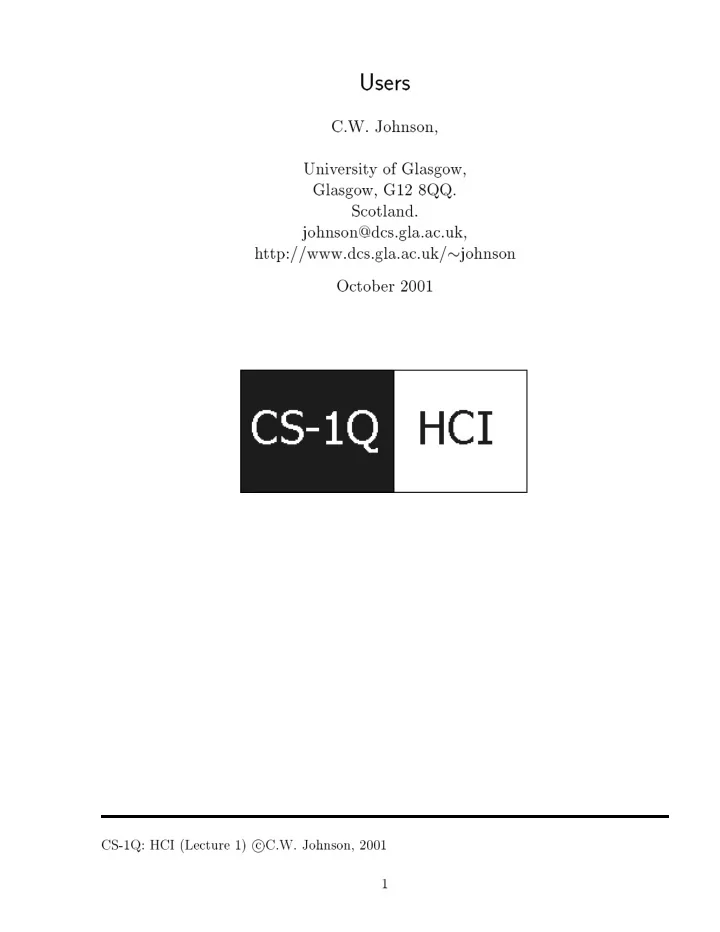

Users C.W. Johnson, Univ ersit y of Glasgo w, Glasgo w, G12 8QQ. Scotland. johnson@dcs.gla.ac.uk, h ttp://www.dcs.gla .a c.uk/ � johnso n Octob er 2001 c CS-1Q: HCI (Lecture 1) � C.W. Johnson, 2001 1
What is HCI? 1940's: � - Ergonomics fo cuses on study of w o rk. 1950's & 1960's: � - fo cus on Human F acto rs of machine interaction. 1980's & 1990's: � - fo cus on Human Computer Interaction. 2000 on: � - back to human facto rs of machine interaction; - computers emb eded in other devices. ubiquitous c CS-1Q: HCI (Lecture 1) � C.W. Johnson, 2001
Users What is a `t ypical' computer user? � What w ould mak e them happ y & p ro ductive? � c CS-1Q: HCI (Lecture 1) � C.W. Johnson, 2001
Users What do y ou think of when y ou use a computer? � System Mental model model Designer User Constructs Interacts with The System (plus documentation) Users develop of the system. mental mo dels � This is di�erent from the designers mo del. � It also di�ers from their mo del of y our mo del. � c CS-1Q: HCI (Lecture 1) � C.W. Johnson, 2001
P erception W e detect signals in our environment. � Infra-red ey e tracking. � c CS-1Q: HCI (Lecture 1) � C.W. Johnson, 2001
P erception What w e detect is a�ected b y: � - absolute and relative signal strength; - anticipation of the signal; - signal to noise ratio. Links b et w een p erception and cognition: � - users often p erceive signals; - but fail to interp ret them; - o r understand their semantics . Anticipation a�ects p erception. � c CS-1Q: HCI (Lecture 1) � C.W. Johnson, 2001
Physiology Physical attributes a�ect abilit y to use devices. � +5 degrees Horizontal plane -10 degrees Normal line of sight -15 degrees -30 degrees RSI, Muscosk eletal injuries etc. � c CS-1Q: HCI (Lecture 1) � C.W. Johnson, 2001
Physiology Designers also mak e assumptions ab out physiology: � - average p erson is not 1.8 meters tall - average p erson do es not w eigh 100kg - no r is their �nger span 21cm. If w e designed fo r the average who w ould w e exclude? � c CS-1Q: HCI (Lecture 1) � C.W. Johnson, 2001
Cognition Ho w do users think ab out the systems they use? � Di�erent emphasis on memory . short and long term � Exp erts w o rk at a skilled level; � - if something go es wrong w e might use some rules; - if all else fails try general kno wledge. c CS-1Q: HCI (Lecture 1) � C.W. Johnson, 2001
Environment External impact on cognition, p erception and physiology . � What can y ou control? � - heat, noise, vib ration, colleagues? - don't w o rk next to a p rinter... c CS-1Q: HCI (Lecture 1) � C.W. Johnson, 2001
Culture Globalisation o r fragmentation? � Japanese version of Microsoft W o rd: � - to ok 2-3 y ea rs to develop; - team of lo cal p rogrammers; - T oky o usabilit y lab. Cultural diversit y within a nation (US, Scotland?). � c CS-1Q: HCI (Lecture 1) � C.W. Johnson, 2001
Age By 2008, will b e mo re p ensioners than scho olchildren. � ageing : Chr onolo gic al � - natural rate at which w e lose our faculties; - ma y not b e able to see so w ell etc. F unctional ageing: � - rate b ey ond the chronological ageing; - can b e asso ciated with w o rkplace injuries. c CS-1Q: HCI (Lecture 1) � C.W. Johnson, 2001
Gender W omen have b etter spatial a w a reness? � Gender related terminology? � - `kill' a p ro cess o r `ab o rt' a p rint job. Men ma y b e b etter at interrupt handling? � Thematic vagab onding and encysting. � c CS-1Q: HCI (Lecture 1) � C.W. Johnson, 2001
Disabilit y Key concept of essibility . ac c � Screen readers and b raille displa ys. � W o rd p rediction systems. � Scripts based communication. � Many technologies transfer into the mass ma rk et. � c CS-1Q: HCI (Lecture 1) � C.W. Johnson, 2001
Summa ry Users a re not designers. � Physiology , P erception, Cognition. � Environment, Culture, Age, Gender. � c CS-1Q: HCI (Lecture 1) � C.W. Johnson, 2001
F urther Reading \In the ligh t of the scien ti�c evidence, pregnan t w omen do not need to stop w ork with VDUs. Ho w ev er, to a v oid problems caused b y stress or anxiet y , w omen who are w orking with VDUs should b e giv en the op- p ortunit y to discuss their concerns with someone adequately informed of curren t authoritativ e scien ti�c information and advice." (Health and Safet y Executiv e) Shneiderman on: � - human diversit y , pp 18-27; - individual and so ciet y 585-600. c CS-1Q: HCI (Lecture 1) � C.W. Johnson, 2001
Recommend
More recommend